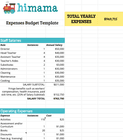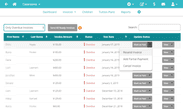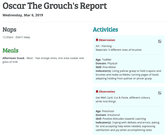Complete guide to starting and growing a home-based childcare center
A home-based childcare center can be a great business opportunity for aspiring entrepreneurs who love children. When operating out of your home, the startup costs and risks are low when compared to other businesses, while the opportunity for monetary and emotional rewards are high.
There are many things to consider when deciding to open a in home child care center. First and foremost, you will need to have a thorough understanding of early childhood education. You will have children in your care that are in the stage of life where they are doing the most important cognitive development, and so it is your responsibility to provide them with a suitable environment to meet their needs.
Additionally, even though it is in your home, a home daycare is still a business and needs to be thought of as such. From budgeting and taxes to licensing and regulations, you will need to handle the business side of child care as well.
Table of contents
Before you start
Opening an at home daycare center does not mean simply stating that your home is now a daycare.
From legal requirements to supplies, there are many items you will first need to sort out for your daycare center business to have everything it needs to get started working with children and to provide care for a rewarding career.
Business plan for your at home daycare
The very first step towards opening your home daycare is thinking like a business, and a proven way to do so is by creating a business plan. There are many different ways to create a business plan and you can find many templates online to help get you started.
Writing a business plan is a helpful exercise that forces you to plan ahead and anticipate many of the challenges that can often lead to failure when they are overlooked, such as:
- Is there enough demand for home-based child care providers in your area (e.g. are there more families with young children in your area than existing daycares can accommodate)?
- How much will it cost to operate your business?
- How much will you need to charge per child, and do you have enough space?
- How will you promote your business to get young children enrolled?
In general, the more thorough your business plan is, the better prepared you’ll be to open your daycare business. Things will naturally change as you go, but your business plan will give you a solid foundation to build off of.
Business/legal structure
There are many different ways to structure your business from a legal standpoint. There may be different options based on your area, so check your government websites for information they provide on business structures.
For example, you may wish to open as a sole proprietorship, partnership, or incorporation. Each option has different pros and cons for liability, taxes, profits and several other factors.
Additionally, rather than opening as a brand new business, you may wish to become part of a home-based childcare center agency. This would mean more help starting up and getting children enrolled, but less profit overall because the agency will take a commission of sales.
Funding
There are many costs involved with starting an in home daycare. Toys, mats, first aid kits, cleaning supplies, binders, markers, paper, food, software, insurance, registering your business, advertising…all the little things begin to add up.
Hopefully you already have enough funding saved up, but chances are you will need to do some outside fundraising.
Aspiring entrepreneurs usually start off asking friends and family to invest in their business. This can be just a simple loan, or you may offer a percentage of your business in exchange for their funding (especially if they are providing a large amount).
You can also check with your bank to see if you can be approved for a business loan. These will often have notable interest rates, however, so make sure that you will be able to repay these loans in a timely manner without it impacting your business too much.
As a child care provider and small business, you may be eligible for local grants or subsidies. Check your local, state/provincial or federal websites to see what is available of new child care businesses. You may be able to get a substantial portion of your funding just by applying to these programs, which can also help you lower your enrollment costs to help benefit parents as well.
Name and branding
A great name can really help your home daycare stand out, which is why it’s important to put effort in the beginning towards creating a great name and brand for your business.
Try to think of a name that is clever and easy to remember, while at the same time tells people what your business is. This is much easier said than done, and coming up with the perfect name can take days or weeks.
Use a notepad or the notes app on your phone to jot down an idea whenever you have one so you don’t forget it. Once you have a lot of names, start picking your favorites. Then share these in conversation to see what others think of your name options.
If you’re feeling completely stuck, give our preschool name generator a try!
Once you have your name, create a logo and choose some brand colors. It may seem like you don’t need this yet, but pretty soon you will be printing things with your logo, sharing it on social media, creating signs, and many other things involving a logo. By doing this work upfront, you will have done the hard work first, and your materials will be consistent because you won’t be changing things as you go.
If you need a bit of help, Coolors can help you choose a color scheme, and there are many online logo designers like Hatchful that can help you choose a font and image for your logo.
Getting started
Once you’ve finished creating your business plan and decided that opening a home-based childcare center is right for you, it’s time to get to work!
Before you open your doors, there are plenty of logistics to think through and set up. This opening a home daycare checklist will help set you on the right track.
Budget
One of the most important things to do as you get started is to figure out how much it will actually cost to run your business. By creating a thorough budget, you will be able to prioritize what are the essential items your in home daycare you will need and which ones are nice-to-haves. This will also help you figure out how many children you will need to enroll and how much their tuition should be.
It can be challenging when creating a budget to be sure that you have thought of every possible thing. If you need a little help, give our free child care center budget template a try.
Insurance
As careful as you may be, accidents can happen — especially in child care. If they do, you will definitely want to have a good insurance plan to ensure that you are covered. Depending on what plan you choose, in home daycare insurance can cover essential things like:
- Property
- Crime
- Business income
- Liability
- Equipment breakdown
When creating your budget, insurance may seem like an extra expense to cut down on, but it will be well worth the cost when compared to the alternative of going out of business.
Licensing
Depending on your location, it may be an option to run your home-based childcare center with or without a license. Even still, it is in your best interest to license your home daycare and understand licensing requirements.
Just think of it from the parent’s point of view: Your child is the most precious thing in the world. Would you really be comfortable sending them to a random person’s house, or would you rather send them to a properly licensed child care center?
By licensing your in home daycare, parents will know that your program meets all of the standards established by your government. Doing so will also likely make you eligible for different funding and professional development opportunities, which can have a significant impact on the success of your business.
Learning philosophy
A home-based childcare center is not group babysitting. Ages zero through five are the most important years for a child’s cognitive development and a majority of what – and how – they learn will be with you.
There are several learning philosophies to choose from, with the most common being:
- Montessori
- Waldorf
- Reggio Emilia
Additionally, there are typically state of provincial educational frameworks that your government recommends (and in some cases requires), or assessment frameworks you can purchase like the Ounce Scale or Work Sampling System from Pearson.
To start, check with your government websites to see what they recommend or require. If you are becoming licensed, you may have already found the assessment and curriculum you will be following.
Safety
When you’re responsible for a group of children, safety needs to be one of your top priorities.
The first step is to safety-proof your home. Minimize the chances for injuries by removing furniture with sharp corners, covering electrical outlets, securing bookshelves to the wall, and so on.
Next, be prepared for any medical emergencies by getting CPR training if you do not have any already.
It is also a good idea to run regular fire drills and have an action-plan ready should an emergency occur.
Billing and payments
It goes without saying that you will need to collect money in order to sustain your business. When starting your home daycare, you will need to figure out how you will bill customers and collect payments.
Sending invoices and tracking payments can be a lot to keep track of while you have all of the other things to manage when running your business, so choose a system that will help make this easier. For example, using HiMama allows you to create and send invoices to parents, track payments, and even collect payments electronically from their credit card or bank account.
For more help getting started, see your complete guide to billing and payments for child care centers.
Hiring
Although staffing requirements are much lower than a child care center not run out of a home, you will likely not be able to do everything on your own. Your licensing or government frameworks may require a certain teacher-to-child ratio. Plus, with all of the other administrative duties, meal prep and cleaning, it can be a lot to manage as one person.
Working at an in home daycare can mean wearing many different hats in terms of responsibilities. Figure out what you enjoy most about being a child care provider and focus on those duties, then get help for the other things that need attention.
When looking for employees, focus on candidates who are clearly passionate about child care. It can be demanding and low-paying work, so those who love what they do will be your greatest assets.
Activity planning
Each and every day, you will need to plan out what the children will do to fill up their day. Do some research on different activities to try at your home-based childcare center, and keep track of the ones that the kids most enjoy and benefit from.
This is also how you will promote their development through whichever learning philosophy you are following. Chances are that the framework or approach you are using have well-documented activities that they recommend.
Parent communication
Now more than ever, parents expect regular communication with their child care provider. They will want to know what their kids have been up to all day, which is why most childcare centers will provide daily sheets.
It can be difficult to fill out paper daily sheets in the moment, and so educators may have to fill them in later relying on their memory, leading to inaccurate reports. For that reason, you may want to consider digital activity tracking and reporting, so you can easily make observations as they happen and share them in real-time (and with a photo for good measure).
You will also want to be able to easily and effectively communicate with parents to send reminders, notes for the next day, or emergencies. A child care app can make this a lot simpler and faster, which will make a difference after you get up and running.
Supplies
The most expensive part of getting your home-based childcare center up and running will likely be all of the supplies you will need, which will generally be either for the classroom or operational supplies. Classroom supplies are things like furniture, books and toys, while operational supplies include cleaning sprays, toilet paper, food, and so on.
To help cut costs, you may be able to find second-hand items like furniture and books, but just make sure they are in good condition and you have properly cleaned them before bringing the kiddos in! You can also implement a policy where parents provide some basic supplies for their children. For example, their child’s favorite toy, some basic stationery or their own diapers and wipes for infants.
Marketing
To get children enrolled at your home daycare, you will need to first put the word out. Marketing can be a challenge for any business that’s starting out, but there are some tried and true strategies that often work for daycare providers. An informational brochure or postcard can be a great way to communicate all that your home-based childcare center has to offer. You can create quick and simple designs using a platform like Canva.
When parents are deciding between the many different providers in your area, having something in front of them to refer back to will allow you to be present during those conversations without actually being there. You can even make a day of it by walking around the neighborhood to drop them off in your neighbors’ mailboxes!
If you want to take your marketing to the next level, you can also advertise online on Google and Facebook. We’ll get into that in more detail in the next section, but you may also want to consider hiring a marketing consultant to help do these things for you while you focus on other tasks.
Growing your child care provider business
Once you’ve conquered the biggest challenge of getting up and running, at some point you may wish to take your business to the next level. After all, kids grow up fast, meaning that you’ll need to find new customers sooner than later.
Below are some of the many things you can do to further legitimize your home daycare and attract new customers.
Accreditation
Earning accreditation means that your business meets a high level of standards for different aspects of child care such as education and safety. Being accredited provides you with an easy way to communicate with parents that your business is among the best in your community.
There are several ways to become accredited. For example, many U.S. states offer a Quality Rating and Improvement System (QRIS), which have their own set of criteria to recognize different levels of excellence. There are also professional membership organizations like NAEYC, which have their own requirements and are widely recognized as authorities in the early education space.
By becoming accredited, parents will know that you are following all of the important guidelines that keep their children safe and are providing developmentally appropriate programming. Accredited child care businesses can also be eligible for funding opportunities not available otherwise.
Online listings
Try doing a Google search for “home daycares in [your city]” and see what websites come up. If there are local websites that list other daycares in your area, try contacting them to see if they will list your business as well. It can be helpful to also provide a description of your business that they can include on their website.
If you see directory websites like Yelp, you can create a free listing for your business. Make sure you are thorough and provide as much information as possible, so your business will look good when compared to the competition. Directory websites will typically have a “freemium” model, where it is free to get started and you can pay to have additional features, which you may want to consider if you begin to see good results from your listing.
Website
Although many home-based childcare centers get enough enrollment through word of mouth, it can never hurt to create a website for your business. If a parent is considering your center, having a website helps legitimize your business and gives them a place to learn more about your services. Plus, you will begin appearing in search results, exposing your business to new potential customers.
Luckily, creating a website is now easier than it has ever been. See our post on how to create a home-based childcare center website to learn how!
Referral program
No matter how much advertising you do, nothing beats a recommendation from a trusted friend or family member for convincing a potential customer to choose your business.
Although you can’t make someone recommend you if they don’t actually want to, a referral program will incentivize them to spread the word about how great you are. Even something as simple as a $25 Starbucks gift card can give parents that extra push to tell a few more friends or post a link to your website on Facebook. Just one additional customer earned through a referral could make the entire program worth it.
Social media
Social media is a great way to connect with your existing and potential customers online. Create a Facebook or Instagram page for your business and begin sharing content. These can be updates from your center, sharing links to relevant articles you’ve found online, commenting on others’ posts, sharing videos, and so on.
Just make sure that whatever you do is appropriate and enforces the idea that you are a great child care provider. This is not the time to share your opinion on the latest political scandal. Think more along the lines of an article with tips on how to make bedtime easier.
If your budget allows, you can also create paid social media. Even spending as little as $30 could be enough to reach thousands of parents in your area.
Search engine optimization
When searching for daycares in your area, you want your business to appear in those results. A website is essential to be listed (as outlined above), but there are more ways to be found in search results.
To be listed in Google Maps results, you can create a free Google My Business listing. This allows you to share a description, your hours, location, photos, contact information, and other important things about your business. You will also be able to collect reviews from your customers, which can make a big difference when potential customers are browsing your listing.
Running a home-based childcare center can be an incredibly rewarding experience and provides a valuable service to your community. In this guide, we’ve broken down the major steps involved with getting up and running, but there are always more tips to be shared. Let others know in the comments what has helped you run your child care center!
Embed This Infographic On Your Site (copy code below)
<div><a href="/blog/complete-guide-to-starting-growing-a-home-daycare-center/" title=”How to Open a Home Daycare” alt=”How to Open a Home Daycare” border=”0″/><img src="/blog/wp-content/uploads/2019/07/How-to-Open-a-Home-Daycare.jpg" /></a><br/><br/>
<div> Courtesy of: <a href=”https://www.himama.com/”>Himama</a></div></div>Related posts
- Pros & Cons of Opening a Preschool Program
- How to Create a Child Care Center Business Plan
- How to Run a Home Daycare with Technology
- How to Create a Home Daycare Website
- When is the Right Time to Open a New Child Care Center in My City?
Run your home daycare like a superstar!
If you’re thinking of adding an app to your childcare center, we’d love to talk!
HiMama facilitates open communication with families and enables contactless operation of your center, from documentation to payments. We support tens of thousands of centers and can’t wait to help you too! Learn more about the app with a FREE tour.
Michael writes for HiMama's early childhood education blog and ECE Weekly newsletter. When not developing content for early childhood professionals, he can usually be found out and about with his wife and daughter exploring all that Toronto has to offer, or playing music with his karaoke band.
More by Michael
Michael Keshen
March 11th, 2021
27 mins
Related Articles

The Benefits of Loose Parts Play for Young Children
December 10th, 2025 | Maddie Hutchison





